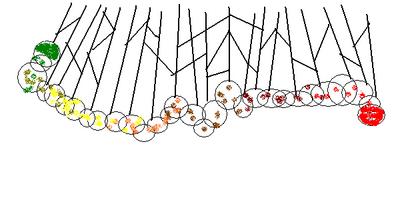A quick word on blocking ads

It looks like you are using an ad blocker. That's okay. Who doesn't? But without advertising revenue, we can't keep making this site awesome. Click the link below for instructions on disabling adblock.
Welcome to the Newschoolers forums! You may read the forums as a guest, however you must be a registered member to post. Register to become a member today!
to some degree you are right, but i would have to disagre with you and most of it.
a species is a population of specimens that inhabit the same region and mate with each other.
I will use your example with the gulls. What happens to them when they get farther away from each other is called divergency, wich is a procces of separation of their distinguishing features. in other words the third gulls you are talking about are a third species and have a similar, but diffrent evolutinary path than the other two.
About the fossils, how can they not be distinct species, acording to you theory the t-rex and the terodactil are one species, wich by every criteria is wrong. Morphologicalty they are diffrent, physiologicaly they are diffrent and so on. all this proves your third thoery wrong. they may both come from the same single celled liveing being, but through evolution they have become diffrent species. and Just because there isn't (to my knowledge) a great diffrence between the last neanderthal and the first homo sapien, dosen't mean that they are the same species. we don't have sientific proof that they wern't Morphologicalty diffrent. maybe what we now think to be fossils of two diffrent species are really the bones of mother and child.
sorry if my terminology isn't that great. i have biology as a profiled class, but not in english.
you can trace it, but they wouldn't be able to mate.

ok, but take the example of melting ice. first all of the ice has to melt into water before it starts warming up. you can't take a bucket of ice, melt half the ice and have the rest of the water become 10 degrees C. first all of the ice must melt, for the water to warm up (or the original species must die, for the new species to be able to mate to the fullest.) things like that occur due to changes in the enviorment.

i'm going to bed, tour theory is only theoreticly possible only if the diffrent species could mate. and all that would happen is a fast forword/rewind effect. and new species in a given genus would be created.
good night rowen, its almost 2 in the mornig here and i have to get up at 6:30.
i think we need to specify the definition of species.
Species (taken from dictionary.com)
Biology. the major subdivision of a genus or subgenus, regarded as the basic category of biological classification, composed of related individuals that resemble one another, are able to breed among themselves, but are not able to breed with members of another species.
Seeing as the gull are metioned aren't morphologicly the same, therefor they are not the same species. another criteria for species is their geographical location. the gulls don't inhabit the same region, therefor they are not the same species. Then their is morphological mutability (i'm pretty sure thats how the term would be in english), wich allows the specimens the change their phenotype, but those changes don't change their genotype, in other words it dosen't affect their offspring.
an example for this is the himalayan rabit. it is normally black at normal tempreture, but if you put a block of ice on its back, the spot where the ice was would turn white. So maybe the gulls changing color is due to their morphological mutability.
bottom line is that there is a very slim diffrence between the diffrent species, but they are diffrent for one reason or another.
And the thoery of infinate species would suggest that me and my mother are diffrent species, wich is not the case. a new species evolves from another once the boarder criteria is crossed.
thats my veiw of this subject, today i almost kicked my biology teacher in the head for being a bitch and giving me an 5 instead of and 6 for the year, fucking bitch. (grades here in bulgaria are from 2 to 6 and no grades inbetween).
the world was started by and is contolled by Lizard Humanoids.
http://en.wikipedia.org/wiki/Reptilian_humanoid
http://www.bibliotecapleyades.net/sumer_anunnaki/reptiles/reptiles.htm